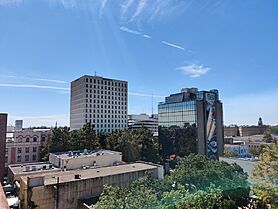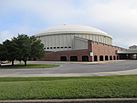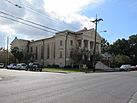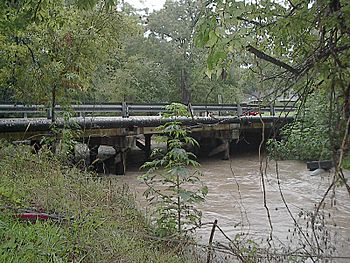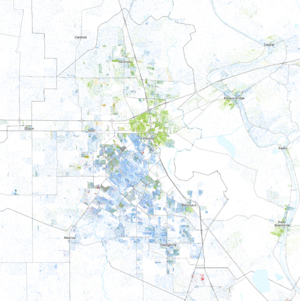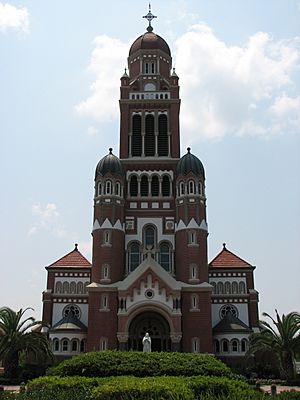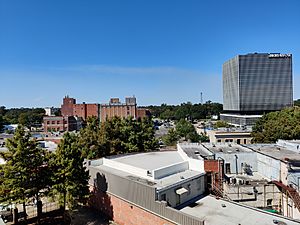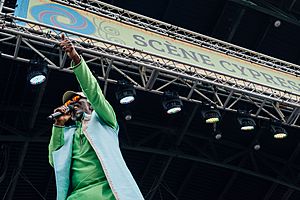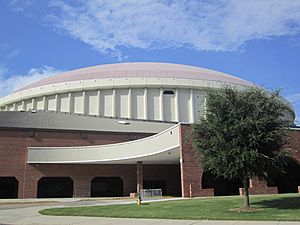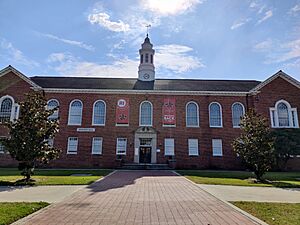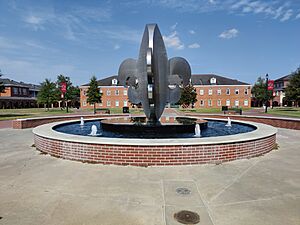Lafayette, Louisiana facts for kids
Quick facts for kids
Lafayette, Louisiana
|
|||||
|---|---|---|---|---|---|
|
Consolidated city-parish
|
|||||
|
Downtown
St. John the Evangelist's Cathedral
Charles H. Mouton House
Old Lafayette City Hall
Cajundome
First United Methodist Church
|
|||||
|
|||||
| Nickname(s):
The Hub City
|
|||||
| Motto(s):
The Heart of Cajun Country
|
|||||
| Country | United States | ||||
| State | Louisiana | ||||
| Parish | Lafayette | ||||
| Founded | 1821 as Vermilionville | ||||
| Renamed | 1884 as Lafayette | ||||
| Founded by | Jean Mouton | ||||
| Named for | General Gilbert du Motier, Marquis de Lafayette | ||||
| Government | |||||
| • Type | Consolidated city–parish | ||||
| Area | |||||
| • Total | 56.00 sq mi (145.03 km2) | ||||
| • Land | 55.92 sq mi (144.83 km2) | ||||
| • Water | 0.08 sq mi (0.20 km2) auto% | ||||
| • Metro | 3,408.5 sq mi (8,828 km2) | ||||
| Elevation | 49 ft (15 m) | ||||
| Population
(2020)
|
|||||
| • Total | 121,374 | ||||
| • Rank | US: 234th | ||||
| • Density | 2,170.57/sq mi (838.07/km2) | ||||
| • Urban | 227,316 (US: 172nd) | ||||
| • Urban density | 1,410.1/sq mi (544.4/km2) | ||||
| • Metro | 478,384 (US: 118th) | ||||
| • CSA | 627,146 (US: 77th) | ||||
| • Consolidated | 244,390 | ||||
| Demonym(s) | Lafayettien | ||||
| Time zone | UTC−6 (CST) | ||||
| • Summer (DST) | UTC−5 (CDT) | ||||
| ZIP codes |
70501–9, 70593, 70596, 70598
|
||||
| Area code(s) | 337 | ||||
| FIPS code | 22-40735 | ||||
Lafayette is a major city in Louisiana, located along the Vermilion River. It is the fourth-largest city in Louisiana. In 2020, about 121,374 people lived in Lafayette. The larger area around Lafayette, called the metropolitan area, had about 478,384 people. This makes it Louisiana's third-largest metropolitan area. Lafayette is known as "The Hub City" and the "Heart of Cajun Country." It is a big center for business and culture between Houston, Texas, and New Orleans.
Lafayette was first started in 1821 as Vermilionville. It became a city in 1836. For a long time, it was mostly a farming community. But in the 1940s, oil was found nearby. This led to a lot of growth and new businesses. Lafayette now has many jobs in the oil and natural gas industry. The city also grew because of new roads and the University of Louisiana at Lafayette.
Today, Lafayette is a key place for technology, healthcare, aerospace, banking, and retail. Many well-known companies have offices or headquarters here. These include Amazon, CGI, JP Morgan Chase, and Ochsner Health System.
Lafayette has a mix of different cultures, especially Louisiana Creole and Cajun people. In 2014, it was even called the "Happiest City in America." The city has many historic buildings and places to visit. It also has important schools like the University of Louisiana at Lafayette.
Contents
- What is the history of Lafayette?
- Where is Lafayette located?
- How many people live in Lafayette?
- What religions are common in Lafayette?
- What is Lafayette's economy like?
- What is the culture of Lafayette?
- What sports are popular in Lafayette?
- What media is available in Lafayette?
- What schools are in Lafayette?
- What military units are in Lafayette?
- How do people get around Lafayette?
- What are Lafayette's sister cities?
- Who are some famous people from Lafayette?
- Images for kids
- See also
What is the history of Lafayette?
Lafayette was founded in 1821 as Vermilionville. It was named after Marquis de Lafayette. Not much is known about the very first settlements before Europeans arrived. The city officially became Lafayette in 1884.
Where is Lafayette located?
Lafayette is located at 30°13′N 92°2′W / 30.217°N 92.033°W. It is about 49 feet (15 meters) above sea level. The city covers about 49.2 square miles (127.4 square kilometers). Most of this area is land, with a small amount of water.
Lafayette is on the West Gulf Coastal Plain. This land used to be part of the seabed a long time ago. The Mississippi River once carved a deep valley nearby, which is now the Atchafalaya Basin. Lafayette is on the edge of this valley. The land here is higher up, so Lafayette usually does not have major flooding problems. The Vermilion River flows through the middle of the city. Other small waterways, like Isaac Verot Coulee, help drain water into the river.
Image gallery
How many people live in Lafayette?
| Historical population | |||
|---|---|---|---|
| Census | Pop. | %± | |
| 1860 | 498 | — | |
| 1870 | 777 | 56.0% | |
| 1880 | 815 | 4.9% | |
| 1890 | 2,106 | 158.4% | |
| 1900 | 3,314 | 57.4% | |
| 1910 | 6,392 | 92.9% | |
| 1920 | 7,855 | 22.9% | |
| 1930 | 14,635 | 86.3% | |
| 1940 | 19,210 | 31.3% | |
| 1950 | 33,541 | 74.6% | |
| 1960 | 40,400 | 20.4% | |
| 1970 | 68,908 | 70.6% | |
| 1980 | 80,584 | 16.9% | |
| 1990 | 94,440 | 17.2% | |
| 2000 | 110,257 | 16.7% | |
| 2010 | 120,623 | 9.4% | |
| 2020 | 121,374 | 0.6% | |
| U.S. Decennial Census | |||
The first people living in the Lafayette area were the Atakapa Native Americans. After the Louisiana Purchase, American settlers moved in. They often married people of French, African, and mixed backgrounds. Since 1860, Lafayette's population has grown a lot. In 2020, it reached 121,374 residents.
The city's population is made up of many different groups. These include people who identify as white, Black, multiracial, and Asian. Many people have European roots, like French, German, English, Irish, and Italian. There have also been Filipino and Hispanic settlers for a long time.
In 2021, most white residents lived throughout the city. Black residents mainly lived in the northern part of Lafayette. Hispanic residents were more common in the central-west area. Asian and multiracial people were spread out across the city.
Lafayette's growth in recent times is partly due to the oil and gas industry. The University of Louisiana at Lafayette and tourism also play a big role. About 5.8% of the people in Lafayette were born in other countries in 2022. The most common languages spoken at home are English, French, and Spanish.
What religions are common in Lafayette?
Like much of Louisiana, Lafayette is a very religious city. Most people are Christian. The Catholic Church is the largest single Christian group. Many people are also Protestants. Among Protestants, Evangelical Protestantism is the biggest group. There are also many historically Black churches.
The Roman Catholic Diocese of Lafayette in Louisiana was started in 1918. Its main church is the Cathedral of Saint John the Evangelist. After Catholics, Baptists are the next largest Christian group. The Southern Baptist Convention is a big Baptist group here. There are also historically Black Baptist churches.
Other Christian groups in Lafayette include Pentecostals, Methodists, Mormons, Lutherans, and Presbyterians. There are also smaller groups like Jehovah's Witnesses and Orthodox Christians.
Besides Christianity, Judaism and Islam are also present. Jewish people began moving to Lafayette in the 1800s. Temple Shalom, one of Louisiana's oldest synagogues, has been in the city since 1869.
What is Lafayette's economy like?
For many years, Lafayette was mainly a farming area. But in the 1940s, the oil and natural gas industry became very important. Today, Lafayette is a major center for this industry in Louisiana.
The city is also growing in other areas. These include technology, healthcare, aerospace, banking, and retail. Many large companies have a presence in Lafayette. Some of the top employers include the Lafayette Parish School System, Lafayette General Health, and the University of Louisiana at Lafayette.
Big companies like Amazon, CGI, JP Morgan Chase, and Ochsner Health System operate here. Major stores like Walmart, Lowe's, and Costco also have a strong presence. The Acadiana Mall is a popular shopping spot.
Lafayette has been recognized as a good place for businesses and careers. Forbes magazine ranked it high for its low cost of doing business and job growth. It's also considered a great place to live due to its affordable living costs.
What is the culture of Lafayette?
Lafayette is a city with a rich and diverse culture. It is part of the Acadiana region, which is known for its unique heritage. Many people in Lafayette have Louisiana Creole and Cajun backgrounds. There is also a growing population of people from other countries, especially from Asia.
The city celebrates its different cultures with many annual events. Some popular festivals include Festivals Acadiens et Créoles and Festival International de Louisiane. People also enjoy the Boudin Cookoff and Bacon Fest, and Le Festival de Mardi Gras à Lafayette. You can learn about the local history and culture by visiting places like Acadian Village and Vermilionville Historic Village.
Lafayette is famous for its food! It has many restaurants and is known for its delicious and diverse cuisine. The city also has a lively arts scene. It is home to the Acadiana Symphony Orchestra, Lafayette Ballet Theatre, and various art centers.
What sports are popular in Lafayette?
Lafayette is home to the Louisiana Ragin' Cajuns. These are the sports teams of the University of Louisiana at Lafayette. The city has also hosted several professional and semi-professional sports teams in the past. These include hockey teams like the Louisiana IceGators and football teams like the Lafayette Wildcatters. Soccer teams, such as the Lafayette SwampCats, have also played here.
Today, the Cajun Soccer Club and Louisiana Krewe FC are active soccer teams. Lafayette has many sports venues, including the Cajundome and Cajun Field.
Baseball has a long history in Lafayette. Minor-league baseball teams played in the city from 1907 to 2000. These teams were part of different leagues over the years.
Lafayette is also known as the birthplace of modern trampoline sports. Jeff Hennessy's gymnastics program at the University of Louisiana at Lafayette helped make the sport popular. Many world champions, including his daughter Leigh Hennessy, came from Lafayette. Jeff Hennessy also helped get trampoline included in the Olympic Games.
What media is available in Lafayette?
Lafayette's main daily newspaper is The Daily Advertiser. Other local newspapers include Acadiana Profile and The Independent. The university also has its own paper, The Vermilion. For online news, The Current provides local updates.
There are many radio stations in the Lafayette area, both FM and AM. The city also has several major television stations. These include KATC 3 (ABC), KLFY-TV (CBS), KLAF-LD (NBC), KADN-TV (Fox), and KLPB-TV (PBS).
What schools are in Lafayette?
Primary and secondary education
The Lafayette Parish School System is in charge of public schools in Lafayette. It has 45 schools, including elementary, middle, and high schools. High schools offer special programs called career academies. These help students prepare for specific jobs. Some of the largest high schools are Lafayette High School and Acadiana High School.
Many private schools in the area are run by the Roman Catholic Diocese of Lafayette in Louisiana.
Collegiate and university education
The University of Louisiana at Lafayette is a major university in the city. It is a national research institution with over 18,000 students. It offers more than 100 different study programs. It is the second-largest university in Louisiana.
South Louisiana Community College is also headquartered in Lafayette. This college works with Acadian Ambulance to offer training for EMTs and paramedics. It is part of the Louisiana Community and Technical College System. The Lafayette campus of the Academy of Interactive Entertainment is also here. It teaches students about video game programming, art, and animation.
What military units are in Lafayette?
Lafayette is home to the headquarters of the Louisiana Army National Guard's 256th Infantry Brigade. This unit has over 3,000 soldiers. They have served in places like Iraq. The city also used to have a United States Marine Corps Reserve Unit until 2014.
How do people get around Lafayette?
The Lafayette Regional Airport is the main airport for the area. It has daily flights to cities like Atlanta, Dallas, and Houston. You can also find charter flights and helicopter services here. A new airport terminal opened in 2022.
For road travel, Interstate 10 and Interstate 49 are the main highways. The Amtrak Sunset Limited train offers passenger service a few days a week. It connects Lafayette to cities like New Orleans and Los Angeles. Greyhound also has a bus station downtown.
The Lafayette Transit System provides bus service within the city. Lafayette is also working to become more bicycle-friendly. There are groups like BikeLafayette that promote safe cycling. The University of Louisiana at Lafayette has even built an off-road bike path. Plans are also in place for a recreational trail connecting downtown Lafayette to nearby towns.
Major roads in Lafayette include U.S. Route 90, U.S. Route 167, and Ambassador Caffery Parkway.
What are Lafayette's sister cities?
Lafayette has seven sister cities around the world. These partnerships help connect Lafayette with other cultures and places.
- Le Cannet, Alpes-Maritimes, Provence-Alpes-Côte d'Azur, France (since 1967)
- Longueuil, Quebec, Canada (since 1968)
- Moncton, New Brunswick, Canada (since 1971)
- Poitiers, Vienne, Nouvelle-Aquitaine, France (since 1975)
- Namur, Namur Province, Belgium (since 1979)
- Agnibilékrou, Ivory Coast (since 1999)
- Centla, Mexico (since 2013)
Who are some famous people from Lafayette?
See also: List of people from Lafayette, Louisiana
Many notable people have come from Lafayette. These include:
- Autumn!, a rapper and record producer
- Summrs, a rapper and singer
- Marc Broussard, a singer-songwriter
- Jefferson Caffery, a diplomat
- Christian Keener Cagle, a football player
- Jermell Charlo, a boxer
- Daniel Cormier, a mixed martial artist and wrestler
- Armand Duplantis, a pole vaulter
- Ron Guidry, a baseball player
- Leigh Hennessy, a gymnast and stuntwoman
- Angela Kinsey, an actress
- Dustin Poirier, a mixed martial artist
- Addison Rae, a social media personality and actress
- Eddy Raven, a singer-songwriter
Images for kids
See also
 In Spanish: Lafayette (Luisiana) para niños
In Spanish: Lafayette (Luisiana) para niños


